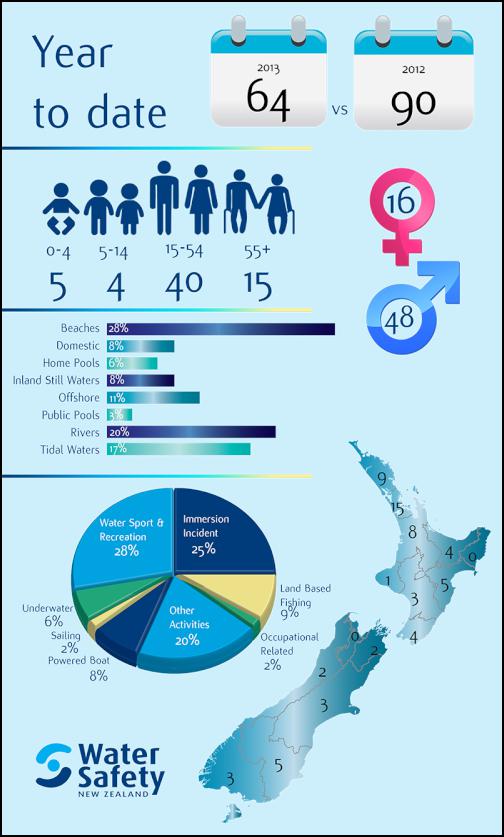Delving deeper - Information from Water Safety NZ
Welcome to Delving deeper, Water Safety New Zealand’s new information and statistics newsletter. Research and information is a core part of creating and continuing efficient sector strategy into what is the third highest cause of accidental death New Zealand. We aim to produce this newsletter quarterly, and hope you find the information included valuable. Please pass it on to others whom you think might find it informative.
You have been sent this newsletter as you have been a subscriber to our WaterWise enewsletter. If you are not interested in receiving this, you are able to unsubscribe below.
Drowning fatalities - as at 25 November 2013

Information Review Group
The water safety sector’s Information
Review Group (IRG) met 9 September 2013. The IRG’s
primary aim is to:
• Identify, prioritise and address
gaps in current data sources and build the current
collection of data for the sector’s knowledge
base;
• Review DrownBase information making appropriate
recommendations on projects and interventions for the
sector.
Over the coming months WSNZ will be contacting
key organisations on behalf of the IRG to establish a
combined sector knowledge repository, sector outcome
measures, revise the current Drowning Report and work on
enhanced mechanisms to distribute data to the sector.
Should you want further detail please contact Alexander
Brunt, General Manager on alex@watersafety.org.nz.
Doctoral scholarship
Water Safety New Zealand (WSNZ) is offering a 3-year PhD scholarship ($25,000 p.a. + negotiable costs) at the University of Otago. The candidate will conduct research that will support the Research Strategy of WSNZ. Applications have now closed and there will be an announcement made shortly.
More information on the PhD scholarship
Recreational boating drowning
fatalities
WSNZ has been looking into the issue of lifejackets in recreational boating to find out what focus can be taken to produce the greatest value in saving lives and minimising injuries.
Under current rules, boats must carry enough appropriate lifejackets for the number of people on board. In addition, local councils may have their own bylaws expanding on this rule. For example, in Queenstown, everyone on board a craft smaller than 6m in length must wear a properly secured lifejacket at all times. Many local councils have less than 6m in length as the limit for mandatory lifejacket usage – is this the size that best incorporates the majority of drowning deaths?
Using DrownBase™ data, WSNZ completed an analysis of all recreational boating drowning fatalities for the 20 year period 01/01/1993 to 31/12/2012. For each fatality, the analysis identified gender ethnicity, age group, environment (e.g. river, lake beach, tidal waters, offshore), region, craft size/type and, where possible, whether other conditions (e.g. weather, alcohol or drug consumption) were a possible contributing factor.
A diagram of the summary of research and analysis can be found here – the majority factor in each category is highlighted in red. In the 400 recreational boating fatal drownings over the 20 year period that was analysed, 265 (66%) of the drowning deaths occurred in craft that were less than 4m in length; either non-powered (kayaks, rafts, etc) or powered. In 76% of these cases, a life jacket was not worn.
From this research and
analysis, WSNZ has created a discussion paper on the subject
of lifejackets that it is currently taking to relevant
organisations in the sector. The discussion points
are:
• Continue focus on skipper responsibility and
education, particularly targeting:
1. NZ European males
aged between 15-34 needing to wear lifejackets in craft less
than 4m in length offshore and in tidal waters in the
northern half of the North Island;
2. Ability to
communicate distress following an immersion-type
accident;
3. Weather and sea conditions;
4. Fitted
level flotation for craft smaller than 4m;
5. Alcohol
consumption.
• Advocate for legislation for mandatory
wearing of lifejackets for craft smaller than 4m when
underway.
• Advocate for industry support for fitted
level flotation for craft smaller than 4m.
• Sign the
Muskoka Accord (International principles for the wearing of
lifejackets on recreational craft).
Next issue
Please let us know if there are any particular statistics you would like to see in this newsletter. Suggestions can be made to: wsnz@watersafety.org.nz.


 Pharmaceutical Society of NZ: Launch Of PSNZ Position Statement And Priority Areas Of Focus
Pharmaceutical Society of NZ: Launch Of PSNZ Position Statement And Priority Areas Of Focus Jack Yan: A Farewell To Arms Re-released, In The Form Ernest Hemingway Intended
Jack Yan: A Farewell To Arms Re-released, In The Form Ernest Hemingway Intended Baycourt Community and Arts Centre: Talofa Papa - A Celebration Of Laughter, Love And Family
Baycourt Community and Arts Centre: Talofa Papa - A Celebration Of Laughter, Love And Family Bikesport NZ: 2025 Honda New Zealand Motocross Grand Prix At Woodville - Greatest Show On Turf A Memorial Event
Bikesport NZ: 2025 Honda New Zealand Motocross Grand Prix At Woodville - Greatest Show On Turf A Memorial Event Crohn's and Colitis NZ: Camp Purple Live 2025 - Celebrating A Decade Of Fun And Friendship For Kids And Teens With Inflammatory Bowel Disease
Crohn's and Colitis NZ: Camp Purple Live 2025 - Celebrating A Decade Of Fun And Friendship For Kids And Teens With Inflammatory Bowel Disease Creative Waikato: Building Wellbeing In Social Housing Through Creative Solutions
Creative Waikato: Building Wellbeing In Social Housing Through Creative Solutions